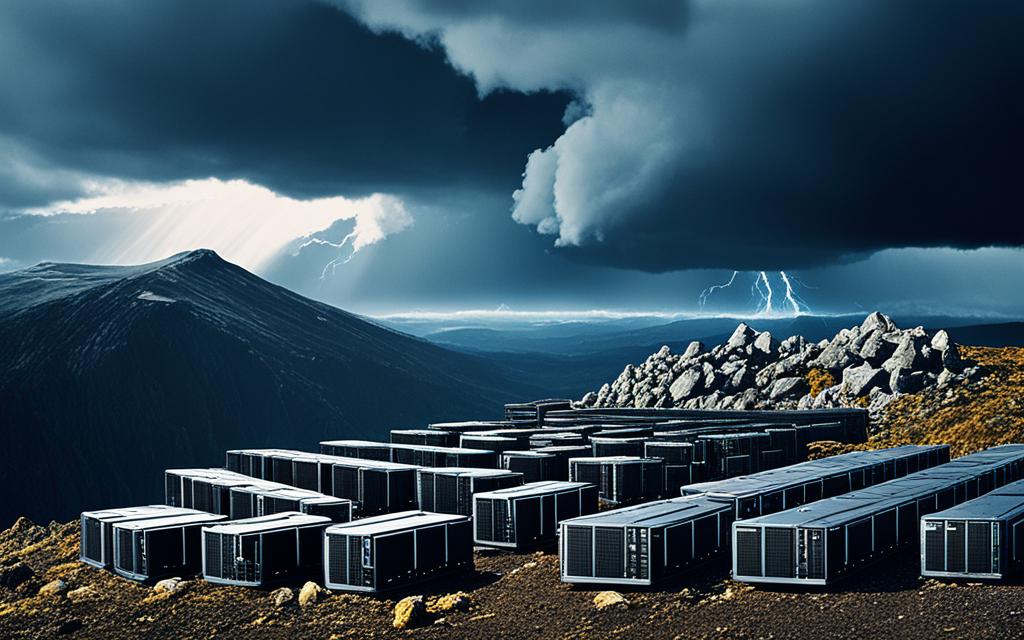Table of Contents
The shift to cloud computing has been a significant change for many organizations. It began in the mid-20th century with the invention of the transistor in 1947. This moment was crucial, marking the start of modern computing1. Ideas that laid the groundwork for today’s technology started to form.
The tech scene evolved, leading to the popularity of personal computers by Apple and Microsoft in the 1970s. The 1980s brought the creation of the graphical user interface1. The 1990s saw the commercialization of the Internet. This made information globally accessible, paving the way for cloud technology in the early 2000s2. Organizations now could use computing resources in a more flexible way, without large upfront costs2.
Currently, big names like Amazon, Google, and Microsoft are leading this digital shift. They offer scalable solutions that improve how sectors work together and increase efficiency2.
Looking ahead, the future seems bright with cloud computing being central13. We’re seeing advancements in AI and the Internet of Things. These developments hold great promise for IT’s future.
Key Takeaways
- The evolution to cloud computing began with the invention of the transistor and progressed through various computing models.
- Cloud computing emerged in the early 2000s, revolutionising how businesses access IT resources.
- Major companies like Amazon Web Services, Google Cloud Platform, and Microsoft Azure are crucial in this transformation.
- Scalable cloud solutions have fostered innovation and enhanced collaboration across businesses of all sizes.
- The future includes advancements in AI, IoT, edge computing, and multi-cloud strategies, promising deeper insights and optimisation.
The Origins of Computing
The journey of modern computing started with simple early computing models. These basic machines worked alone and could only do one thing at a time. As needs grew, technology began to evolve. This move towards complex systems was driven by the aim to support many users at once. Such changes paved the way for important advances in computing.
Early Computing Models
Mainframe computers dominated the tech scene in the 1950s and 1960s. Then, the 1970s and 1980s brought about networked computing. This shift made it possible for many users to access a single machine’s resources. These steps introduced new early computing models. They encouraged people to work together with technology. Both institutions and businesses started to use these models, setting the stage for what was to come.
Introduction to Distributed Systems
Distributed systems changed how computers work together. For the first time, different computers could act as one. This made sharing resources easier and made everything run more smoothly. Key features of these systems included being able to scale up, stay available, and handle problems well. They led directly to the creation of cloud computing. In 1963, DARPA gave MIT $2 million for a project that let many users access computers at once. This project was a step towards the cloud computing we know today4. Soon after, in 1997, Professor Ramnath Chellapa described cloud computing in terms of economics, not just technology4
| Year | Event | Significance |
|---|---|---|
| 1961 | John McCarthy proposed computing as a utility | Conceptual foundation for cloud computing |
| 1999 | Salesforce.com implemented internet deliverables | Marked the birth of Software as a Service (SaaS) |
| 2002 | Amazon launched Amazon Web Services (AWS) | Provided internet-based storage and computation |
| 2006 | Introduction of Elastic Compute Cloud | Pioneered public cloud services |
From the origins of computing to the complex distributed systems of today, technology has come a long way. The drive for better collaboration and efficiency fuels ongoing innovation4.
Transition to Distributed Computing
The move from traditional to distributed computing marks a key stage in the evolution of computing. It’s vital to understand this change to see how technology has adapted for industry and consumer needs. We’ll look at what distributed systems are and how mainframes have driven this shift.
Defining Distributed Systems
Distributed systems can work across many places. This approach greatly improves how resources are used and increases scalability. It overcomes the old system’s location limits, helping organisations work more efficiently and flexibly.
The Role of Mainframe Computing
Mainframes started in the 1950s for big data tasks. They laid the groundwork for later computing styles, helping to lead to distributed computing. Despite their costs, they were key for managing massive data and pushing fast technological progress5.
The shift towards cheaper, cluster computing broke mainframes’ limits. This change is a vital part of computing’s growth, leading to more flexible IT resources for organisations.
| Aspect | Mainframe Systems | Distributed Computing |
|---|---|---|
| Cost | High initial investment | Generally lower operational costs |
| Flexibility | Less flexible | Highly adaptable |
| Geographical Limitations | Location-bound | Operates across various locations |
| Efficiency | Standardised processing | Improved resource utilisation |
The move from mainframe to distributed computing is a major tech leap. It sets the stage for modern infrastructures.
With more recognition of distributed systems’ benefits, computing keeps evolving. This shapes computing’s future6.
Evolution to Cloud Computing
The journey to modern computing has reshaped our world, making adaptability and creativity key. Exploring how cloud computing has evolved, we see crucial milestones along the way.
Emergence of Virtualization Technologies
Virtualization began about 40 years ago, changing how we manage computer resources7. It lets multiple virtual instances run on a single machine. This efficiency set the stage for cloud computing8.
In the early 2000s, virtualization’s growth marked a critical point for cloud computing. It helped companies grow by using resources better.
The Impact of Web 2.0
In 2004, Web 2.0 reshaped the internet into a space where users interact more9. This led to higher demand for user-friendly online services. These changes encouraged cloud applications that make sharing and interaction easy9.
With more people creating content, the need for stronger cloud setups grew. This opened up new opportunities for companies and developers.
Introduction of Service Oriented Architecture
The start of service-oriented architecture (SOA) marked a big leap. It helps businesses create flexible services to meet changing needs. Quality of Service (QoS) and Software as a Service (SaaS) became critical cloud aspects8.
As cloud services like IaaS, PaaS, and SaaS developed, giants such as Amazon Web Services and Microsoft Azure led the way. They revolutionized IT services and infrastructure.
| Technology/Concept | Year Introduced | Significance |
|---|---|---|
| Cloud Computing | 1950s | Initial concept with time-sharing. |
| Mainframes | 1951 | Enabled critical tasks for large organisations. |
| Cluster Computing | 1980s | Connected computers for enhanced processing. |
| Grid Computing | 1990s | Created a virtual supercomputer for complex tasks. |
| Virtualization | Early 2000s | Enabled efficient resource utilisation in cloud. |
| Web 2.0 | 2004 | Transformed the internet into an interactive platform. |
| Service Oriented Architecture | 2000s | Enhanced service integration across applications. |
Looking back at cloud computing’s evolution shows us an industry ready for more breakthroughs. These steps have paved the way for future innovations.
The Rise of Cloud Services
Cloud services have changed how businesses work, making operations innovative and efficient. Infrastructure-as-a-Service (IaaS) is key for companies needing computing resources via the internet. Since Amazon Web Services launched Amazon Elastic Compute Cloud in 2006, cloud computing has grown hugely. Now, IaaS is vital for all sizes of businesses. It helps break down old barriers in tech10.
Infrastructure-as-a-Service (IaaS)
IaaS lets companies use advanced computing without big investments in physical stuff. This model lets firms adjust resources as needed, making solutions cost-effective and flexible. Adapting to market changes is easier with on-demand resources11. Specialised IaaS serves various sectors like healthcare and finance, offering them what they specifically need10.
Platform-as-a-Service (PaaS) and Software-as-a-Service (SaaS)
After IaaS came Platform-as-a-Service (PaaS). It lets developers make and manage apps without worrying about the base infrastructure. This speeds up innovation and the update process, important for agile businesses. With Software-as-a-Service (SaaS), companies use apps via subscriptions. This gives them an easy way to apply technology10. The cloud’s growing range of services changes operational tasks into strategic improvements11.
The Benefits and Challenges of Cloud Computing
Cloud computing is changing how businesses work. It brings big benefits and some tough challenges for them to deal with. The technology makes things cheaper and more flexible than old ways.
Advantages: Cost-Effectiveness and Flexibility
Benefits of cloud computing include saving money. Companies don’t have to spend a lot on their own IT gear12. They use what they need and pay as they go. This cuts costs a lot13. Also, businesses can easily adjust their storage needs with cloud computing. This is great when user needs change fast14.
Being able to work from anywhere is another plus. The cloud lets teams access data and work together, no matter where they are14. It also keeps data safe and helps businesses keep going if something goes wrong, ensuring they can bounce back quickly12.
Challenges: Security and Compliance Issues
The challenges of cloud services include keeping data safe and following the law. Businesses have to protect their data and follow rules like GDPR. It’s vital they have strong security with cloud providers handling their sensitive information.
To sum up, the benefits of cloud computing are clear, including lower costs and more flexibility. Yet, staying on top of security and legal issues is key for businesses to really benefit from the cloud13.
Conclusion
The journey toward cloud computing has changed how organisations work and grow. It has made businesses more efficient and adaptive. Cloud technology moves forward, changing IT and bringing new ways to keep up with market changes.
Cloud technology will grow with edge computing and artificial intelligence. These advances lead to better efficiency and new cloud computing futures. They allow for faster data use and more tailored experiences. So, firms that adapt and use cloud well will likely do better in the future.
Moving towards agile and multi-cloud methods is crucial for businesses to stay safe and competitive. Embracing green cloud computing shows a commitment to both tech progress and the environment. As things change, using cloud computing is key for organisations wanting to succeed in digital change.
Learn more about cloud computing151617
FAQ
What is cloud computing?
Cloud computing is about using the internet to access computing services. It lets people and businesses store data on remote servers. This approach makes it easier to manage resources without big investments in physical infrastructure.
How has cloud computing evolved over time?
Cloud computing has grown from early systems based on physical resources. Now, it uses distributed systems for better resource sharing. Today, it includes services like IaaS, PaaS, and SaaS.
What are the main service models of cloud computing?
The main models are Infrastructure-as-a-Service (IaaS), Platform-as-a-Service (PaaS), and Software-as-a-Service (SaaS). IaaS offers computing resources on a large scale. PaaS makes application development easier. SaaS lets users access applications over the internet by subscription.
What are the primary benefits of using cloud services?
Cloud computing is cost-effective and flexible. It lets businesses scale resources as needed. This helps them control costs while keeping performance high.
What challenges do organisations face with cloud computing?
Organisations deal with security risks and the need to follow data protection laws like GDPR. They must use strong security measures to protect sensitive information.
How does virtualization contribute to cloud computing?
Virtualization lets multiple virtual systems run on a single physical machine. It’s key for cloud services. It improves resource use and service delivery in the cloud.
What role did Web 2.0 play in the rise of cloud computing?
Web 2.0 made the internet more interactive, which boosted user involvement. It increased the demand for cloud computing by offering dynamic services.
Where is cloud computing headed in the future?
Cloud computing will integrate more with new technologies in the future. It will bring better efficiencies and innovations. This will help organisations keep up and excel in the digital world.
Source Links
- https://www.cimtcollege.com/cimt/news.aspx?id=1279 – A Journey Through Time Cimt College News
- https://www.kloud9it.com/2024/03/the-evolution-and-impact-of-cloud-computing-in-the-digital-age/ – The Evolution and Impact of Cloud Computing in the Digital Age
- https://medium.com/@sadoksmine8/evolution-of-cloud-computing-from-mainframes-to-multi-cloud-fd92e95c476d – Evolution of Cloud Computing: From Mainframes to Multi-cloud
- https://www.dataversity.net/brief-history-cloud-computing/ – A Brief History of Cloud Computing – DATAVERSITY
- https://americancloud.com/blog/the-evolution-of-the-cloud – The Evolution of the Cloud
- https://www.diagrid.io/blog/evolution-of-cloud-computing – The Evolution of Cloud Computing: From Raw Infrastructure to the Serverless Application Cloud | Diagrid Blog
- https://www.geeksforgeeks.org/evolution-of-cloud-computing/ – Evolution of Cloud Computing – GeeksforGeeks
- https://www.beringer.net/beringerblog/the-evolution-of-cloud-computing-from-virtualization-to-serverless/ – The Evolution of Cloud Computing: From Virtualization to Serverless | – NJ, PA, DE, MD | Beringer Technology Group
- https://www.linkedin.com/pulse/tracing-journey-evolution-cloud-computing-ivoyant-llc-w6hbc – Tracing The Journey: The Evolution of Cloud Computing
- https://ascentcore.com/2024/05/29/the-evolution-of-cloud-computing-a-foundational-shift/ – The Evolution of Cloud Computing: A Foundational Shift – AscentCore
- https://www.forbes.com/sites/emilsayegh/2023/11/28/how-cloud-computing-revolutionized-business-operations-and-what-lies-ahead/ – How Cloud Computing Revolutionized Business Operations And What Lies Ahead
- https://suavesol.net/blog/challenges-and-evolution-of-cloud-computing/ – Challenges and Evolution of Cloud Computing
- https://www.veritis.com/blog/cloud-computing-trends-challenges-and-benefits/ – Cloud Computing Trends, Challenges & Benefits
- https://www.spiceworks.com/tech/cloud/articles/what-is-cloud-computing/ – What Is Cloud Computing? Definition, Benefits, Types, and Trends – Spiceworks
- https://fastercapital.com/topics/conclusion-and-future-of-cloud-computing.html – Conclusion And Future Of Cloud Computing – FasterCapital
- https://www.linkedin.com/pulse/evolution-cloud-computing-trends-future-prospects-vijayalakshmi-n – “The Evolution of Cloud Computing: Trends and Future Prospects”
- https://jktech.com.sg/blogs/news/evolution-of-cloud-computing-trends-predictions-for-2024 – Evolution Of Cloud Computing: Trends & Predictions For 2024








